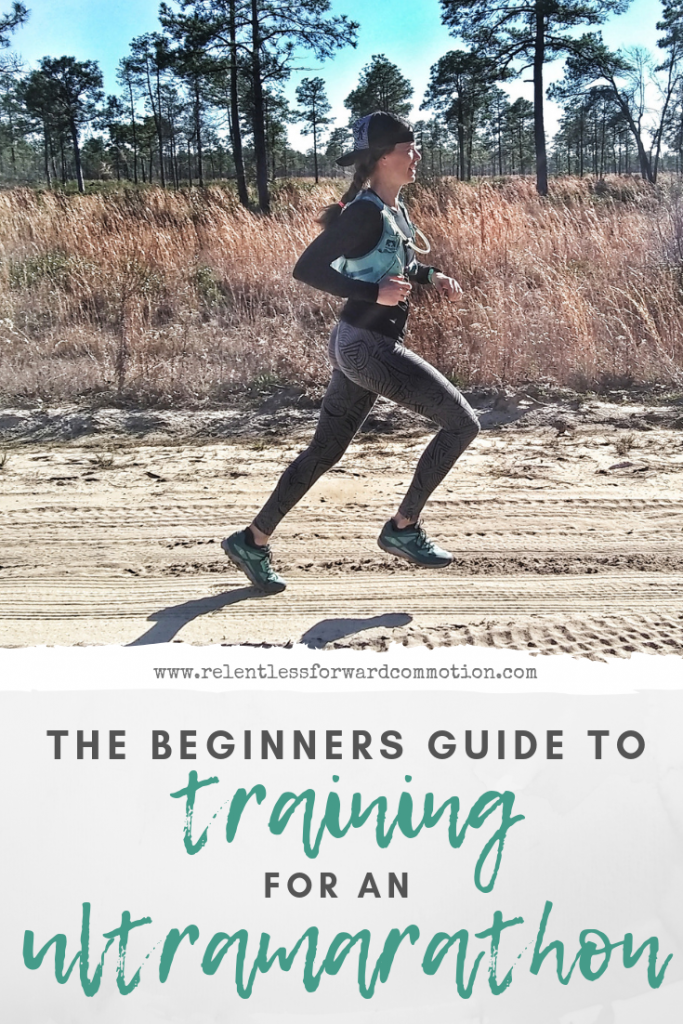Last Updated on January 27, 2022 by Heather Hart, ACSM EP, CSCS
Ready to dip your toes into the ultramarathon world? A 50K – or 31 miles – is the perfect place to start. Those extra 4.8 miles beyond the traditional marathon distance are just long enough to feel like an amazing accomplishment (and it is!) but not so daunting that the distance feels impossible. The 50K distance is a wonderful introduction to the world of ultramarathon running, as well as the perfect opportunity to truly begin to push your personal endurance limits.

Am I ready to train for a 50K?
In order to jump into ultramarathons, runners should have a few years of consistent training under their belts. You should be able to comfortably run at minimum, 35-40 mile weeks. Of course that’s not to say that you can’t train for an ultra in your first year or two of running. However, having that experience will give you the best chances for success in both completing your race and making it through your training cycle injury free. This particular plan starts out at 32 miles in the first week, and builds from there.
Here’s what you need to know about the beginner 50K training plan:
Though I am a full time running coach, I wanted to provide a basic, first time 50K ultramarathon training plan for those who prefer to be self guided, do not need a detailed plan, or who simply aren’t ready for the commitment of working with a coach. While the benefits of working with a coach are invaluable, believe me, I understand it’s not for everyone, or may simply not be financially feasible.
The beginner 50K plan provided at the end of this post is designed to help you successfully reach the finish line of your first 50K. While I do call it a “beginner” plan, it’s far from super low mileage – this is an ultra after all. Again, I don’t believe there are shortcuts to ultramarathons, you’ve got to put in the work. Only you can truly know if you are ready for this type of mileage.

The beginner 50K training plan is pretty basic, I prescribe distances, and will give you a general outline of what you should do during those distances. The exact workout? That’s up to you. This plan also does not address course specifics: is your race flat and beginner friendly? Or is it super technical with a ton of vertical change?
If you need – or want – more specific help, Hart Strength and Endurance Coaching would be more than happy to discuss the possibility of one-on-one coaching to give you a more detailed outline and support to reach your specific ultramarathon goals.
The mileage in this plan slowly and safely builds, with cutback weeks every 3-4 weeks, to allow your body – and mind – to recover and rebuild. The plan finishes off with a cutback week followed by a 2 week taper, ensuring you are rested, recovered, and ready for race day.
The 50K Training Plan Workouts:
A brief run down of what to expect…
Base building runs
The majority of your runs should be done at an easy, aerobic pace. I tell my clients that they should run these at a “conversational pace”. In other words, a pace where you could easily carry on a conversation with a running partner, without feeling as though you are gasping for breath or struggling to speak.
Keeping the majority of your runs at this lower intensity will help prevent injury and burnout as you begin to push the larger weekly mileage volumes, and the longer distance long runs, both required of ultramarathon training. The aerobic zone also encourages fat oxidization (using stored fat for fuel), capillary building, and building a solid endurance base. This is essentially where you become better at running slow miles for a long time.
Hill and speedwork
Once a week, you should incorporate a strength building run – either a speed or hill workout. The mileage prescribed includes warm up and cool down. Again, what you do for that speed or hill workout is up to you. Be creative!

Long runs
Long runs are truly where your body adapts to running for long periods of time, physically and mentally, and are a cornerstone of ultramarathon training. Further, long runs are the perfect “dress rehearsal” for your race. Long runs give you an opportunity to experiment with – and perfect – nutrition and hydration plans, anti chafing products, new shoes or shorts…you get the idea. Long runs should be done at an easy effort pace.
You’ll notice that some of the long runs are provided with a range of mileage. This gives you options, depending upon how you are feeling that day. Struggling to get through, or short on time? Go with the lower end. Feeling amazing, and don’t want to stop running? Hit the higher end of the mileage.
Back to back long runs
Back to back long runs are done to simulate and adapt to running on fatigued legs, which is something you will definitely experience in the later stages of your ultramarathon. It’s also a safer and more efficient way to increase total volume of miles for the week, without putting in extreme long distance runs.
In this training plan, the second long run is prescribed in time, rather than mileage. I find this allows each athlete to truly listen to their body and complete the long run accordingly, rather than pushing to meet an arbitrary number of miles. If you are feeling strong, your body may allow you to push a little further. Feeling beat up from a long week of training? Take it easy, and use the time as a true recovery run.
Important note: weekly mileage totals in the plan are based upon a 10:00/mile pace for the second long run. DO NOT WORRY if your pace is faster or slower, and it changes the overall weekly mileage. Stick with the prescribed time.
Rest days
A common misconception among many runners is that more running = stronger runner, and therefore, many runners loathe rest days for fear that time off will make them lose progress. This couldn’t be further from the truth. Rest days are an integral part of the training process. During rest days, your body recovers from the physical stress of workouts, rebuilds damaged tissue, and becomes stronger. For the love of all things, do not skip your rest days.
Active recovery
During cutback weeks, you will notice active recovery days. These workouts are designed to help promote blood flow, encourage healing, stimulate cardiovascular endurance, but remain low impact. Workouts like: swimming, biking, hiking, yoga, elliptical, etc. are all great options. Keep the effort on the lighter end.
What about strength / cross training?
If you know me, you know I am a huge advocate for strength training and cross training for all runners, but especially for ultrarunners. Strength training is imperative for injury prevention, and building an all around strong, balanced athlete.
While I have not included strength and cross training into this training plan, I 100% encourage you to add it in when you can. You can visit my “Strength Training” page for more resources. Or, for more specific and detailed help, please feel free to inquire about our coaching services.

DISCLAIMER:
The following training plan is designed for educational purposes, and is not a prescribed training plan for any particular individual. While I am a certified exercise physiologist and UESCA & RRCA running coach, and have designed this training plan with safety in mind, you should understand that when participating in a 50K training program, there is the possibility of physical injury. If you engage in this training plan you agree that you do so at your own risk, are voluntarily participating in these activities, and assume all risk of injury to yourself. You should consult your physician or other health care professional before starting this or any other fitness program to determine if it is right for your needs.
If you’d like a full size, printable PDF of this chart, follow this link and fill out the form, and we’ll email you a free downloadable copy!
More helpful resources:
Ultramarathon Racing & Training Tips – a list of numerous educational training posts
The Beginners Guide to Training for an Ultramarathon
Heather Hart is an ACSM certified Exercise Physiologist, NSCA Certified Strength and Conditioning Specialist (CSCS), UESCA certified Ultrarunning Coach, RRCA certified Running Coach, co-founder of Hart Strength and Endurance Coaching, and creator of this site, Relentless Forward Commotion. She is a mom of two teen boys, and has been running and racing distances of 5K to 100+ miles for over a decade. Heather has been writing and encouraging others to find a love for fitness and movement since 2009.




Jane Hall
Will you be doing a 50M program soon?
Heather
Yes! Sometime this week. Stay tuned!
Judy Bell
Hi. Is this training plan suitable for someone looking to finish a road 50k under 5 hours?
Boris
I’m begginer and thanknyou for training plan!!!
Vuangsongbac
I wanted to participate in a triathlon. I just need a trainer who can discipline my lazy body.
Blaine
Thank you for providing a free 50 k ultra training plan. However, when I click on the photo to enlarge as per instructions, it just opens another tab of the same page.
Great website!! Thank you
Heather Hart, ACSM EP-C
Oh strange, something must be up on the backend. Thank you for letting me know, I will look into it!
Ray
The issue of opening a new tab still exists. I’m not able to enlarge or open only the training plan. Which looks excellent by the way!!
Thanks
Heather Hart, ACSM EP
thanks for letting me know, Ray. Currently working with someone to help me with all of the “tech” sides of the blogging, hope to have the issue fixed ASAP!
Janet Knowles
Just FYI, still happening! Is there a link to the enlarged image you can post?
Heather Hart, ACSM EP, CSCS
Fixed it! I apologize for the inconvenience, WordPress kept removing my PDF file so it now lives in a google doc. You should be able to access it using the link provided.
Lu
Hi Heather,
Greetings from Washington, DC! I’m stopping by, long overdue, to say THANK YOU for this plan. When Covid19 and lockdown began last year this time, I began running a few blocks at a time since gyms were closed. A few blocks then became a few miles as running became my safe space and anchor in what felt like an uncontrollable global pandemic. Your 50K plan was successfully followed and I ran my first ultra this past October.
A million times over, thank you!
Paul
Hi, is there a link to download this plan as. pdf? Of have I just missed it?
Sarah
Are the distances prescribed in the plan in miles or kilometers?
Sean
I have the same question!
Lok Gurung
Miles
Last line is race week 31 miles = 50km
Maria
Hi, thanks for making this training plan available for free. Just one question are the distances in the table given in miles or Km?
Best,
Maria
monique Testa
hello my name in monique and I love running i have ran five 50 k and well life happed . I wont go into details however i am getting back into it and i love this sport . my question is are you taking on new client i am someone who need accountability encouragement as well please let me know thankyou
Heather Hart, ACSM EP, CSCS
Hi Monique! Yes I am taking on new clients. Feel free to reach out via our coaching website: https://www.hartendurancecoaching.com/coaching-services/